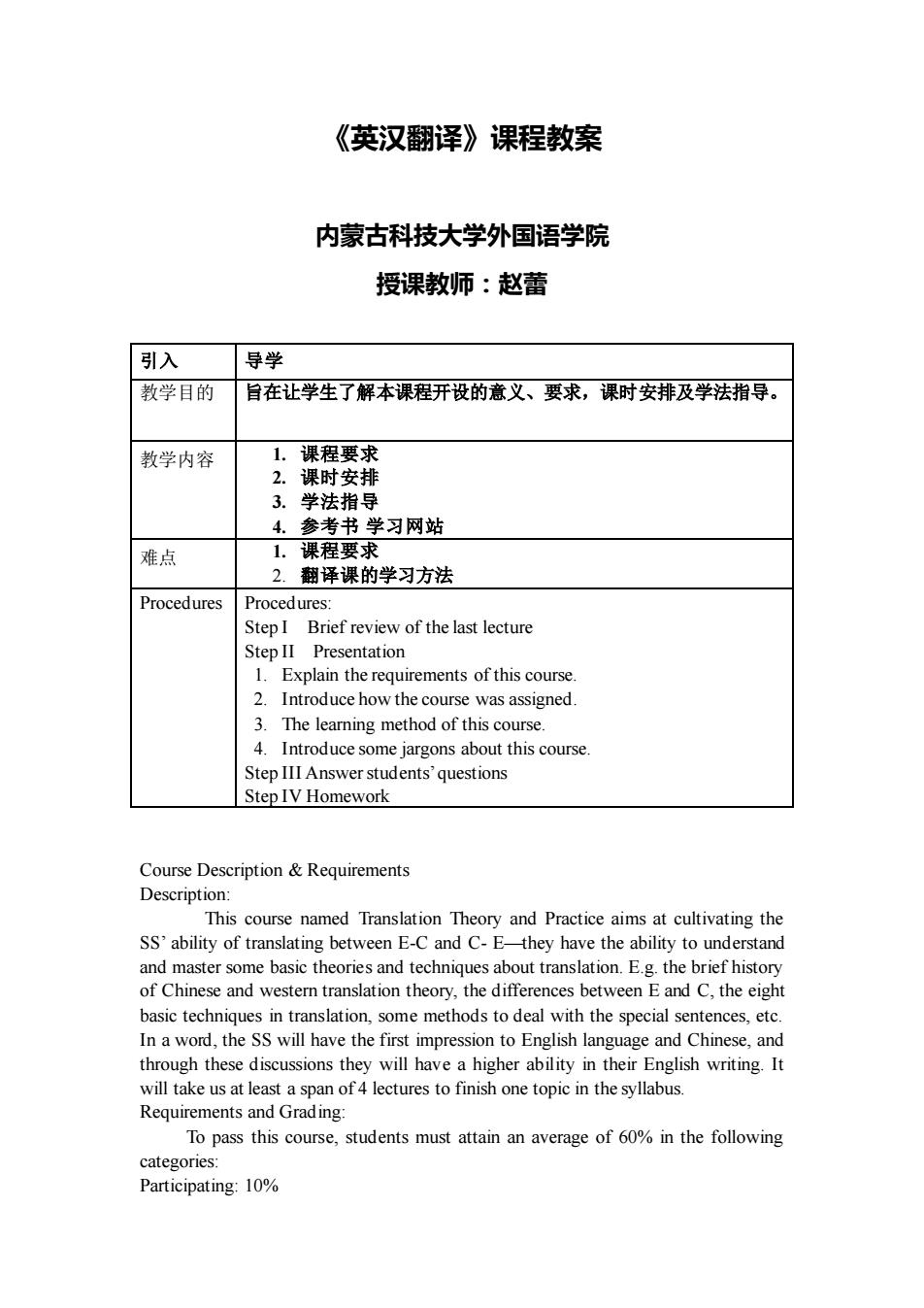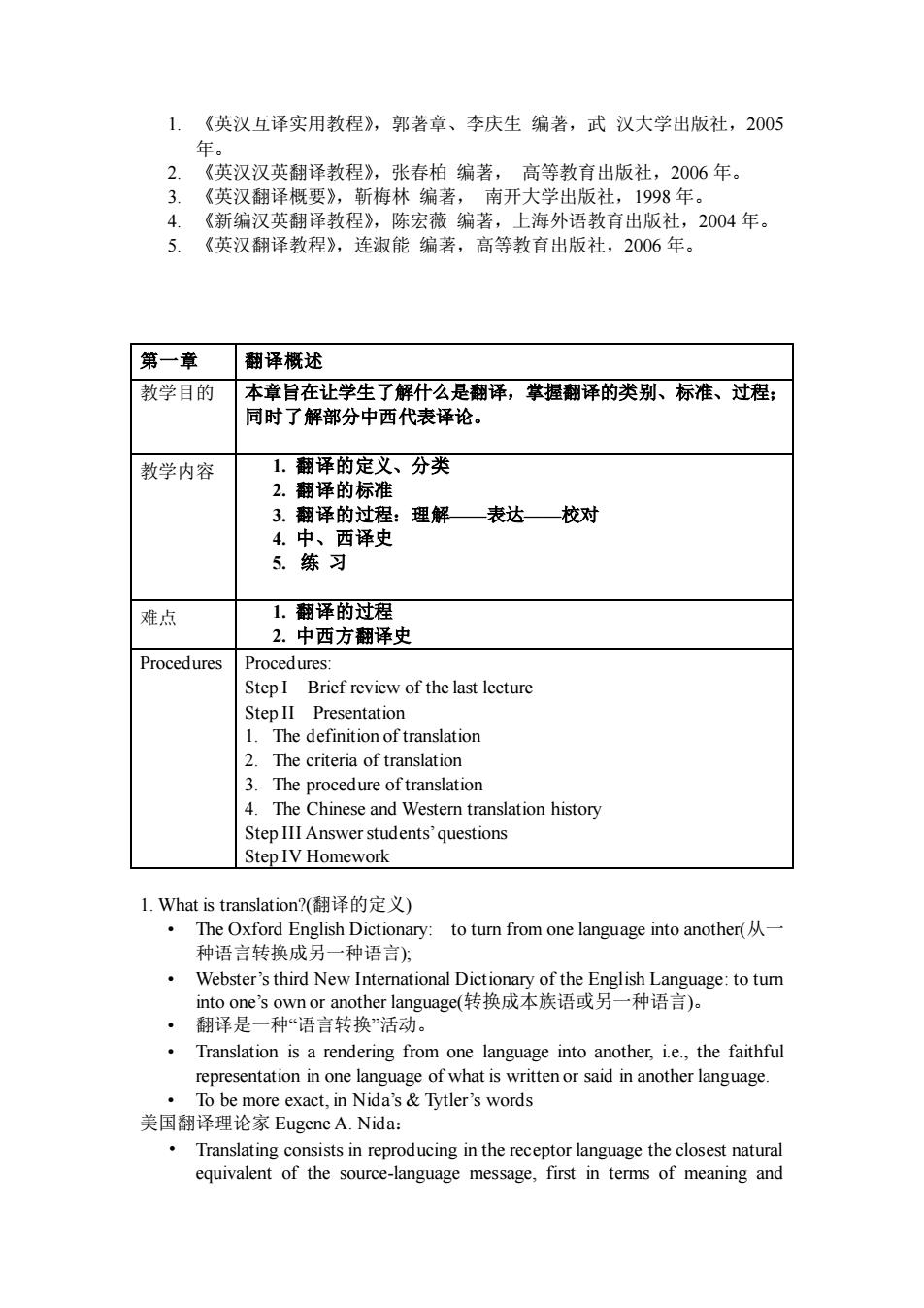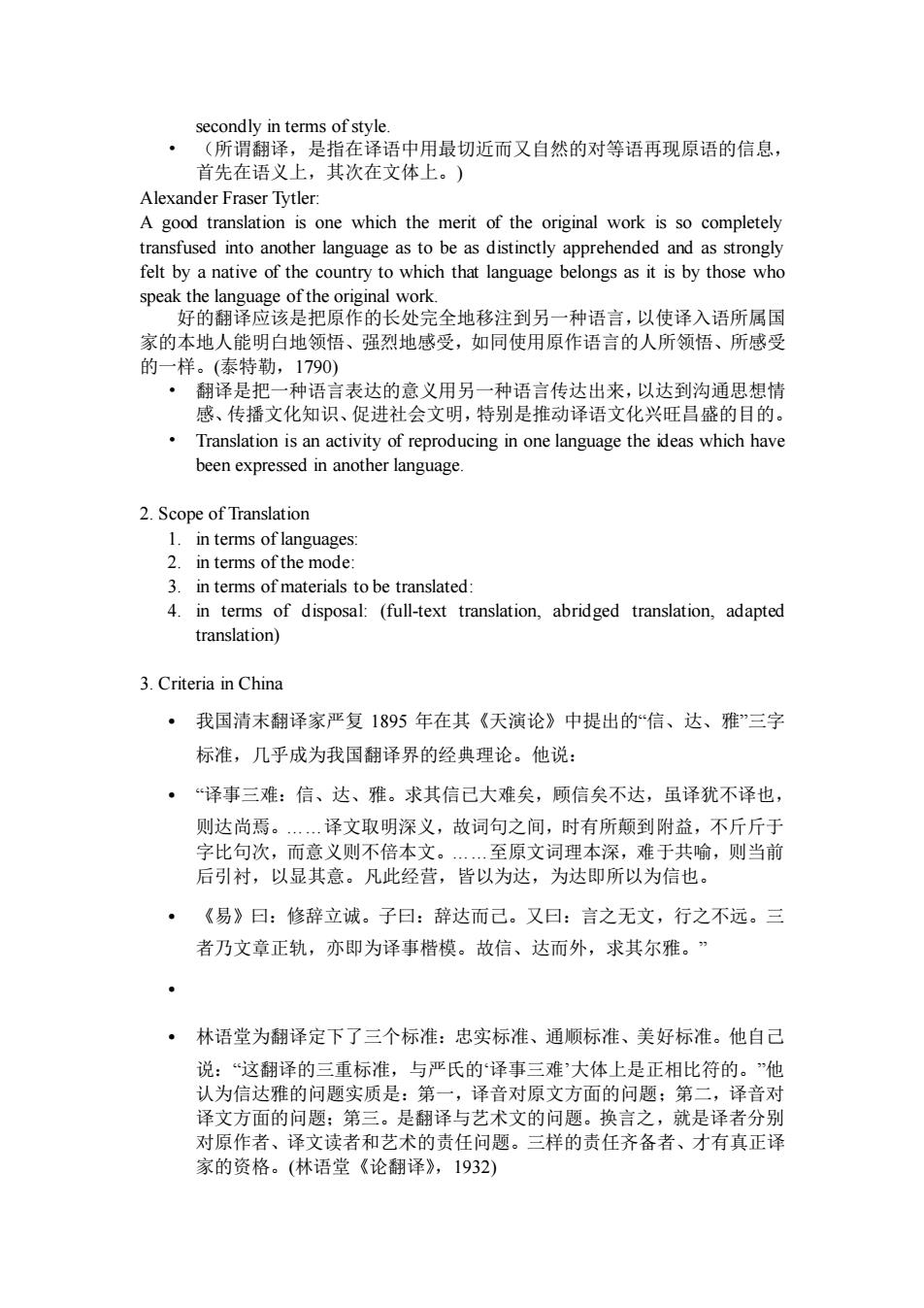
《英汉翻译》课程教案 内蒙古科技大学外国语学院 授课教师:赵蕾 引入 导学 教学目的 旨在让学生了解本课程开设的意义、要求,课时安排及学法指导。 教学内容 1.课程要求 2.课时安排 3.学法指导 4,参考书学习网站 难点 1. 2. 翻译课的学习方法 Procedures StepI Brief review of the last lecture StepII Presentation Explain the requirements of this course 2.Introduce how the course was assigned. 3.The learning method of this course me jargons about this course Answer stu StepIV Homework Course Description&Requirements This course named Translation Theory and Practice aims at cultivating the SS'ability of translating between E-C and C-E-they have the ability to understand and master some basic theories and techniques about translation.E.g.the brief history of Chinese and western translation theory,the differences between E and C,the eight basictec ques in translation. some methods todeal with the special sente ces,et Chinese,and through these discussions they will have a higher ability in their English writing.It will take us at least a span of 4 lectures to finish one topic in the syllabus. Requirements and Grading. To pass this course students must attain an average of 60%in the following categories Participating:10%
《英汉翻译》课程教案 内蒙古科技大学外国语学院 授课教师:赵蕾 Course Description & Requirements Description: This course named Translation Theory and Practice aims at cultivating the SS’ ability of translating between E-C and C- E—they have the ability to understand and master some basic theories and techniques about translation. E.g. the brief history of Chinese and western translation theory, the differences between E and C, the eight basic techniques in translation, some methods to deal with the special sentences, etc. In a word, the SS will have the first impression to English language and Chinese, and through these discussions they will have a higher ability in their English writing. It will take us at least a span of 4 lectures to finish one topic in the syllabus. Requirements and Grading: To pass this course, students must attain an average of 60% in the following categories: Participating: 10% 引入 导学 教学目的 旨在让学生了解本课程开设的意义、要求,课时安排及学法指导。 教学内容 1. 课程要求 2. 课时安排 3. 学法指导 4. 参考书 学习网站 难点 1. 课程要求 2. 翻译课的学习方法 Procedures Procedures: Step I Brief review of the last lecture Step II Presentation 1. Explain the requirements of this course. 2. Introduce how the course was assigned. 3. The learning method of this course. 4. Introduce some jargons about this course. Step III Answer students’ questions Step IV Homework

Participating is vita to cess and it includes being on time coming to class prepared, interacting with other students, and participating in classroom discussions.Students who are frequently absent,tardy,or refuse to participate will receive a poor participation grade.Note:there are NO excused absences.Any absences or tardy will result in a lower participation grade. Speech before class ·1.discussior the translation of google 2.mistakes correction -Here is some“thank-.you”work to be done. 一一这里有些无酬工作要做。 Tha -这可把我难住了。 He is on top of the world 他感到幸福极了。 .Take it from me he is trustable 从我这里拿去 依我看,他值得信赖 What's your pet peeve? Soup with hair on it. ·Peeve=不快,不满 ·Pet peeves=最嫌恶的事 3.new wordsexpressions introduction Card slave Interview buster ·面霸 Fuel-related fare adjustment 油价联动机制 Autistic child 自闭症儿童 Homework:20% teacher may give in the class if there is a need. Tests:60% There will be only one test:a final.But there may also be several short quizzes through the term Attendance:10% Daily attendance will be recorded.3 points for each absence Classroom polices: Late work:Assignments must be turned in on the due date for full credit. Unless otherwise indicated,all assignments will be due at the beginning of the class period.Assignments that are tumed in late will lose %per day
Participating is vital to the learning process and it includes being on times, coming to class prepared, interacting with other students, and participating in classroom discussions. Students who are frequently absent, tardy, or refuse to participate will receive a poor participation grade. Note: there are NO excused absences. Any absences or tardy will result in a lower participation grade. Speech before class • 1. discussion • -the translation of google • 2. mistakes correction • -Here is some “thank-you” work to be done. • -这里有些无酬工作要做。 • -That beats me. • -那个人打我。 • -这可把我难住了。 • He is on top of the world. • 他感到幸福极了。 • Take it from me, he is trustable. • 从我这里拿去, • 依我看,他值得信赖。 • What’s your pet peeve? • Soup with hair on it. • Peeve=不快,不满 • Pet peeve=最嫌恶的事 • 3.new words &expressions introduction • Card slave • Interview buster • 面霸 • Fuel-related fare adjustment • 油价联动机制 • Autistic child • 自闭症儿童 Homework: 20% Students will have to complete periodic assignments related to this course. The teacher may also give homework/ assignments on each topic discussed in the class if there is a need. Tests: 60% There will be only one test: a final. But there may also be several short quizzes through the term. Attendance: 10% Daily attendance will be recorded. 3 points for each absence. Classroom polices: Late work: Assignments must be turned in on the due date for full credit. Unless otherwise indicated, all assignments will be due at the beginning of the class period. Assignments that are turned in late will lose 5% per day

Copying and Plagiarism: Students should do their own work in order to maximize leamning Collaborating on assignments is permitted,but copying another student's s work is prohibited.Similarly,students who are caught copying or plagiarizing will fail the assignment. 课时安排: 教学内容 课时 导学 第一章:翻译概述 第二章:英汉语言对比 第三章:词语的翻译 第四章:句子翻译技巧(上) 第五章:句子翻译技巧(下) 第六章:常见文体的翻译 译者素养: >译者的素质: 外语素质 母语素质 语言敏感度 百科能力 心理素质 翻译的轴助工县: 工具书 百 电子辞典 在线词典 提高方法: 1.翻译理论+翻译技巧+翻译实践 研究有关翻译的论述,弄懂翻译的基本问题。 (阅读理论著作:专题论文:翻译教材:译品的前言后语) 2.研究译作范本 从中摸索翻译的规律和技巧,对比不同译本的处理和效果 研究典型 注意翻译技巧的说明和译句的得失,为翻译实践打好基础 3. 不断进行翻译实践 (1)依照词语一句子一段落一语篇的顺序: (2)选择不同题材和体裁的练习材料: (3)难易循常渐进, 4 译文反复修改 ,不断提高译文质量 选择有参考译文的文本,进行对比学习: (6)可请别人修改或校正。 参考书:
Copying and Plagiarism: Students should do their own work in order to maximize learning. Collaborating on assignments is permitted, but copying another student’s work is prohibited. Similarly, students who are caught copying or plagiarizing will fail the assignment. 课时安排: 教 学 内 容 课 时 导 学 2 第一章:翻译概述 4 第二章:英汉语言对比 4 第三章:词语的翻译 4 第四章:句子翻译技巧(上) 8 第五章:句子翻译技巧(下) 8 第六章:常见文体的翻译 6 译者素养: ➢ 译者的素质: 外语素质 母语素质 语言敏感度 百科能力 心理素质 翻译的辅助工具: 工具书 百度 电子辞典 在线词典 提高方法: 1. 翻译理论+翻译技巧+翻译实践 研究有关翻译的论述,弄懂翻译的基本问题。 ( 阅读理论著作;专题论文;翻译教材;译品的前言后语) 2. 研究译作范本 从中摸索翻译的规律和技巧,对比不同译本的处理和效果。 研究典型译例,注意翻译技巧的说明和译句的得失,为翻译实践打好基础 3. 不断进行翻译实践 (1) 依照词语-句子-段落-语篇的顺序; (2) 选择不同题材和体裁的练习材料; (3) 难易循序渐进; (4) 译文反复修改,不断提高译文质量; (5) 选择有参考译文的文本,进行对比学习; (6) 可请别人修改或校正。 参考书:

1.《英汉互译实用教程》,郭著章、李庆生编著,武汉大学出版社,2005 2. 《英汉汉英翻译教程》,张春柏编著,高等教育出版社,2006年 3. 《英汉翻译概要》,靳梅林编著,南开大学出版社,1998年。 4. 《新编汉英翻译教程》,陈宏薇编著,上海外语教有出版社,2004年。 5.《英汉翻译教程》,连淑能编著,高等教育出版社,2006年。 第一章 翻译概述 教学目的 本章旨在让学生了解什么是翻译,举握翻译的类别、标准、过程 同时了解部分中西代表译论。 教学内容 1.翻译的定义、分类 2.翻译的标准 3.翻译的过程:理解—表达—校对 难点 1.翻译的过程 2.中西方翻译史 Procedures Procedures: StepI Brief review of the last lecture Step II Presentation 1.The definition of translation The criteria of translation The procedure of translation 4.The Chinese and Western translation history Step III Answer students'questions StepIV Homework L.What is translation?(翻译的定义 The Oxford English Dictionary:to tur from one language into another( 种语言转换成另一种语言上 Webster's third New Intemational Dictionary of the English Language:to tum into one's own or another language((转换成本族语或另一种语言)。 。 翻译是一种“语言转换”活动。 Translation is a rendering from one language into another,i.e.,the faithful representation in one language of what is written or said in another language. To be more exact,in Nida's Tytler's words 美国翻译理论家Eugene A.Nida: Translating consists in reproducing in the receptor language the closest natura equivalent of the source-language message,first in terms of meaning and
1. 《英汉互译实用教程》,郭著章、李庆生 编著,武 汉大学出版社,2005 年。 2. 《英汉汉英翻译教程》,张春柏 编著, 高等教育出版社,2006 年。 3. 《英汉翻译概要》,靳梅林 编著, 南开大学出版社,1998 年。 4. 《新编汉英翻译教程》,陈宏薇 编著,上海外语教育出版社,2004 年。 5. 《英汉翻译教程》,连淑能 编著,高等教育出版社,2006 年。 1. What is translation?(翻译的定义) • The Oxford English Dictionary: to turn from one language into another(从一 种语言转换成另一种语言); • Webster’s third New International Dictionary of the English Language: to turn into one’s own or another language(转换成本族语或另一种语言)。 • 翻译是一种“语言转换”活动。 • Translation is a rendering from one language into another, i.e., the faithful representation in one language of what is written or said in another language. • To be more exact, in Nida’s & Tytler’s words 美国翻译理论家 Eugene A. Nida: • Translating consists in reproducing in the receptor language the closest natural equivalent of the source-language message, first in terms of meaning and 第一章 翻译概述 教学目的 本章旨在让学生了解什么是翻译,掌握翻译的类别、标准、过程; 同时了解部分中西代表译论。 教学内容 1. 翻译的定义、分类 2. 翻译的标准 3. 翻译的过程:理解——表达——校对 4. 中、西译史 5. 练 习 难点 1. 翻译的过程 2. 中西方翻译史 Procedures Procedures: Step I Brief review of the last lecture Step II Presentation 1. The definition of translation 2. The criteria of translation 3. The procedure of translation 4. The Chinese and Western translation history Step III Answer students’ questions Step IV Homework

secondly in terms of style (所谓翻译,是指在译语中用最切近而又自然的对等语再现原语的信息 首先在语义上,其次在文体上。) Alexander Fraser Tytler: A good translation is one which the merit of the original work is so completely transfused into another language as to be as distinctly apprehended and as strongly felt by a native of the count to which that language belongs as it is by those wh speak ong 全地移注到另一种语言,以使译入语所属国 家的本地人能明白地领悟、强烈地感受,如同使用原作语言的人所领悟、所感受 的一样。(泰特勒,1790) ·翻译是把一种语言表达的意义用另一种语言传达出来,以达到沟通思想情 感、传播文化知识、促进社会文明,特别是推动译语文化兴旺昌盛的目的。 Translation is an activity of reproducing in one language the ideas which have been expressed in another language 2 Scope of Translation 1 2. 3.in terms of materials to be translated: 4.in terms of disposal:(full-text translation,abridged translation,adapted translation) 3.Criteria in China ·我国清末翻译家严复1895年在其《天演论》中提出的信、达、雅”三字 标准,几乎成为我国翻译界的经典理论。他说: ·“译事三难:信、达、雅。求其信己大难矣,顾信矣不达,虽译犹不译也 则达尚焉。 译文取明深义,故词句之间,时有所颠到附益,不斤斤于 字比句次,而意义则不倍本文。 .至原文词理本深,难于共喻,则当前 后引衬,以显其意。凡此经营,皆以为达,为达即所以为信也。 《易》曰:修辞立诚。子曰:辞达而己。又日:言之无文,行之不远。三 者乃文章正轨,亦即为译事楷模。故信、达而外,求其尔雅。” ·林语堂为翻译定下了三个标准:忠实标准、通顺标准、美好标准。他自己 说:“这朝泽的三重标准,与取氏的泽事三难大体上是正相出符的。”他 认为信达雅的问题实质是:第 译音对原文方面的问题:第 译音对 译文方面的问题:第三。 是翻译与艺术文的问题。换言之,就是译者分别 对原作者、译文读者和艺术的责任问题。三样的责任齐备者、才有真正译 家的资格。(林语堂《论翻译》,1932)
secondly in terms of style. • (所谓翻译,是指在译语中用最切近而又自然的对等语再现原语的信息, 首先在语义上,其次在文体上。) Alexander Fraser Tytler: A good translation is one which the merit of the original work is so completely transfused into another language as to be as distinctly apprehended and as strongly felt by a native of the country to which that language belongs as it is by those who speak the language of the original work. 好的翻译应该是把原作的长处完全地移注到另一种语言,以使译入语所属国 家的本地人能明白地领悟、强烈地感受,如同使用原作语言的人所领悟、所感受 的一样。(泰特勒,1790) • 翻译是把一种语言表达的意义用另一种语言传达出来,以达到沟通思想情 感、传播文化知识、促进社会文明,特别是推动译语文化兴旺昌盛的目的。 • Translation is an activity of reproducing in one language the ideas which have been expressed in another language. 2. Scope of Translation 1. in terms of languages: 2. in terms of the mode: 3. in terms of materials to be translated: 4. in terms of disposal: (full-text translation, abridged translation, adapted translation) 3. Criteria in China • 我国清末翻译家严复 1895 年在其《天演论》中提出的“信、达、雅”三字 标准,几乎成为我国翻译界的经典理论。他说: • “译事三难:信、达、雅。求其信已大难矣,顾信矣不达,虽译犹不译也, 则达尚焉。.译文取明深义,故词句之间,时有所颠到附益,不斤斤于 字比句次,而意义则不倍本文。.至原文词理本深,难于共喻,则当前 后引衬,以显其意。凡此经营,皆以为达,为达即所以为信也。 • 《易》曰:修辞立诚。子曰:辞达而己。又曰:言之无文,行之不远。三 者乃文章正轨,亦即为译事楷模。故信、达而外,求其尔雅。” • • 林语堂为翻译定下了三个标准:忠实标准、通顺标准、美好标准。他自己 说:“这翻译的三重标准,与严氏的‘译事三难’大体上是正相比符的。”他 认为信达雅的问题实质是:第一,译音对原文方面的问题;第二,译音对 译文方面的问题;第三。是翻译与艺术文的问题。换言之,就是译者分别 对原作者、译文读者和艺术的责任问题。三样的责任齐备者、才有真正译 家的资格。(林语堂《论翻译》,1932)